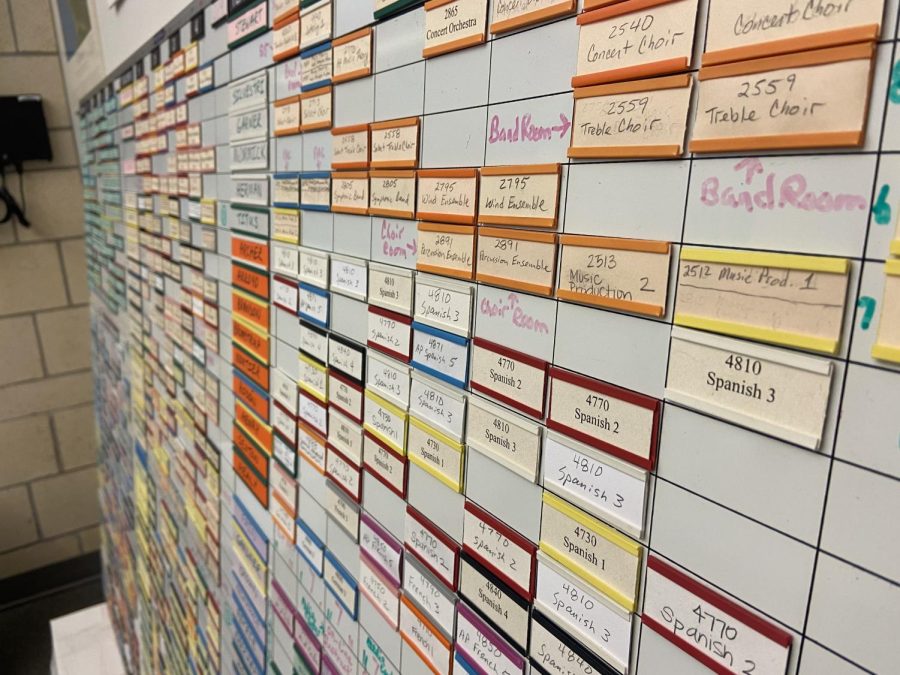Meet the staff member behind Fossil’s master schedule
The master schedule whiteboard in Torvik’s office contains information for every class in Fossil.
When you walk into Scott Torvik’s office, the first thing that catches your eye is the huge whiteboard that takes up nearly all the wall space. It is filled with different colored chips with classes written on them, each row organized by teacher and each column labeled with a class period. This mess of color and class names is the entire schedule at Fossil Ridge High School. Soon, it will be wiped and restarted for the 2022-2023 school year.
Torvik is in charge of creating the master schedule at Fossil, which will dictate student’s individual schedules in the upcoming school year. Even though he is not the only one who works on the schedule–counselors are also heavily involved–he does much of his work alone. Once students meet with their counselors, the data about how many students request each class goes to Torvik. “I’m able to compile reports to know the number of students that have selected each course,” Torvik said.
After determining how many students want which course, he provides recommendations to the rest of the Fossil staff. A big part of Torvik’s job is figuring out how many staff members and classrooms the school needs, and how much money it would cost. “This would be my recommendation for the number of sections that should be offered, etc,” Torvik stated, “These are the numbers of staff that we would need to make that happen.”
Only after all the numbers are crunched can Torvik actually begin to form the schedule. “Once those decisions of funding is made for sections and stuff, positions, all those things, then I can get to work here and make decisions about placement,” he said. Much of the work he does in determining the schedule is by himself, working alone and with a computer to schedule classes.
Before he places classes into a computer program, he has to check when each class meets, and if they overlap. “I go into my period offerings and I try to arrange single offered and double offer classes in the most advantageous spots that I can so that students don’t have to choose between this or that,” he noted. “And so when I’m done with that, I’m able to use that to run loads to test my thinking right, and how well his classes load.”
“The first attempt [to make the schedule] is by the computer loader,” Torvik expressed. After the computer attempts the first schedule, Torvik then goes in and corrects it. Torvik uses different colored “chips” on the whiteboard to indicate how many times a class is offered in a year. “So a lot of information associated with each chip in the computer runs to try to arrange a schedule that I can complete.”
Scheduling does not stop for Torvik after the final master schedule is complete. He is involved in the add-drop process, although he does not quite enjoy it. “I encourage students to make informed choices about what classes they think they need to enjoy, right? And stick with as many of them as possible,” he said. A lot of the changes at add-drop come down to what he calls “student preference”. A student might drop a fourth period class because they want to leave school early or do not enjoy the teacher, rather than the class not working in their schedule. “After I have worked for weeks to perfect this and after counselors have corrected problems or scheduled difficulty for students, we give students the option to express their personal preference.”
In the past, the format of the schedule has not changed much from year to year. But this year, drastic changes were made, including the removal of advisory and the addition of the block system. “It just made it different,” Torvik explained. Instead of advisory, freshman students were required to take a new class, Sabercat 101. Torvik had a challenge scheduling that particular class, he said. “It can only happen in the first and second quarter because the decision was made that I couldn’t schedule them in the 3rd or 4th quarter.” This restriction made it a lot harder for Torvik to schedule classes, since several period blocks were taken up by Sabercat 101 in the first semester.
These changes did not make it necessarily more difficult for Torvik to schedule, however. “So changing a schedule doesn’t make scheduling easier. It’s just different. Yeah, you just have to account for different things,” he said.
It is not only registration week for Fossil students, it is also registration week for students looking to go to the new Timnath Middle-High School. Torvik said that the school does not know if the schedule will be affected by the new school opening, but he thinks that it might lead to more openings for classrooms. “There could be fewer students that are needing to be scheduled, eases up on the facility demand, and so there may be more rooms available for a period that didn’t exist for this year, because this year we were extremely tight [with room space].”
The choices that students make this week will influence how Torvik will design the master schedule. Torvik hopes that students will remember to choose classes that they will be excited and stick with even after summer. “What students don’t grasp, it’s not their job to do that [make the schedule], is that we build a schedule and find a schedule based upon the information that happens between tomorrow and March 11.”
Your donation will support the student journalists of Fossil Ridge High School. Your contribution will allow us to purchase equipment and cover our annual website hosting costs.

Lizzy Camp is a senior and is elated to be entering her final semester as Editor in Chief, alongside Jordan Brownhill. She has spent four years working in the newsroom and has contributed many amazing articles, podcasts, and photos to Etched in Stone. She is excited to continue growing the Etched in...











